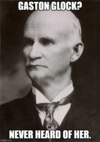where to start...
The 1911 pistol was assembled...as in on an assembly line...not "built" by hand.
The 1911 isn't a complex piece of machinery. As it was originally delivered...and redelivered throughout WW2...it's actually fairly crude when compared to many other designs. It wasn't intended to be complex. It was intended to be treated like a borrowed mule and serviced in the field without the need for a skilled gunsmith or even an armorer for most repairs and parts replacements. The gun can be completely disassembled without the need for tools, save the sights, plunger tube, ejector, and grip screw bushings. Complex machines don't tend to fare very well on battlefields.
The myth that early 1911s had a lot of hand fitting needs to be put to rest. It was the intent of the designer and the US Army that parts be fully interchangeable precisely so they WOULDN'T need fitting by a skilled gunsmith. While the first contract pistols sometimes didn't freely interchange between one vendor's pistol and another because of minor variations in parts dimensions, it usually only required a little cherry picking to get one up and running. Even extractors had a blueprint specification for the correct amount of bend so that the tension in a within-spec slide would be correct and there was rarely a need for any adjustment.
Before the 2nd contract, Colt, in conjunction with Springfield Armory...the real Springfield Armory...set about revamping the specs and tolerances to insure complete parts interchangeability regardless of vendor, and tey developed a system of GO and NO-GO gauges for nearly every part and subassembly in the gun...and it worked. They then proved it by selecting two pistols from each of the five vendors and completely disassembling the,...tossing the parts in a large basket...and assembling 10 working pistols without regard to what went where. The pistols had to not only meed function and accuracy requirements, they had to meet standards for appearance. For example, there could be no misalignment of frame and slide at the rear.
Thus, the concept of the drop-in part came to be.
So, here it is again.
The 1911 pistol was designed to function. If it's correctly built to spec and fed decent ammunition from a proper magazine, it WILL function. It's a machine. It doesn't have a choice.
And for all who've never seen it happen...the no-tool detail strip, courtesy of John M. Browning. Apologies for not removing the grips. Norinco didn't see fit to size and dish the screws correctly for that operation. DUe to the occasional glitch with You Tube, you may need to back the video up to the beginning.





